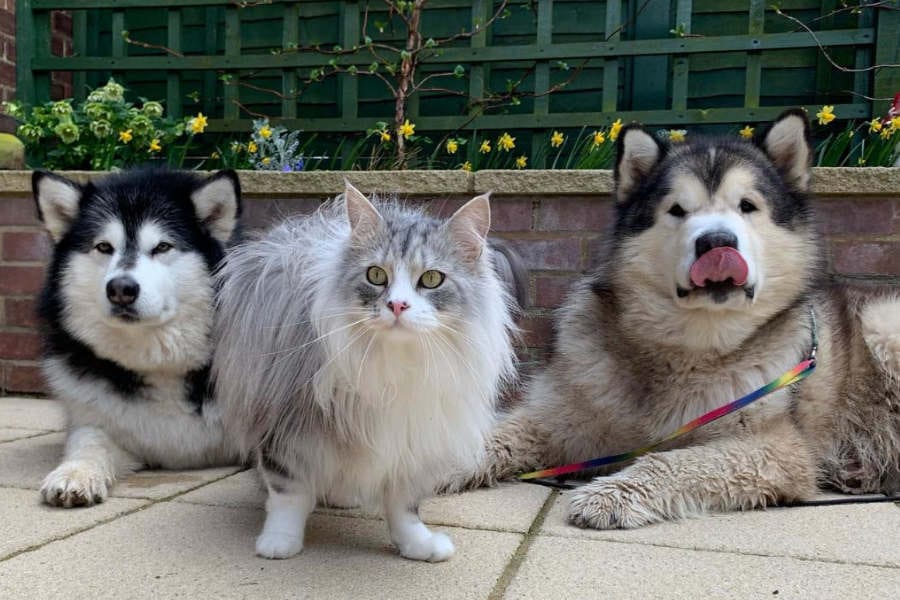Alaskan Malamutes are one of the oldest and largest sled dog breeds, known for their strength, endurance, and loyalty. They are often used for pulling heavy loads over long distances in extreme weather conditions. However, one question that many people have when considering getting an Alaskan Malamute is whether they are good with cats.

While Alaskan Malamutes are generally friendly and gentle with people, their prey drive can make them a potential danger to cats and other small animals. As natural hunters, they may see cats as prey and chase them, even if they are raised together from a young age. Therefore, it is important to introduce an Alaskan Malamute to a cat slowly and carefully, and to always supervise their interactions to ensure the safety of both animals.
Alaskan Malamute Temperament
Alaskan Malamutes are a breed of dog known for their friendly and affectionate nature. They are generally loyal and devoted to their owners, and can make excellent family pets. However, it is important to note that they have certain instincts and behaviors that can make them challenging to live with in certain situations.

Prey Drive and Hunting Instincts
One of the most important things to consider when thinking about whether an Alaskan Malamute is a good fit for a household with cats is their prey drive. Alaskan Malamutes are a breed of dog that has been developed for hunting and pulling sleds. As a result, they have a strong instinct to chase and capture prey.
This can be a problem if you have cats in your home. Even if your Alaskan Malamute is well-trained and socialized, they may still be tempted to chase or attack your cats. It is important to supervise any interactions between your Alaskan Malamute and your cats, and to take steps to prevent any aggressive behavior.
Socialization and Training
Socialization and training are key factors in determining whether an Alaskan Malamute will be good with cats. Alaskan Malamutes are generally friendly and sociable dogs, but they can become aggressive if they are not properly socialized and trained.
It is important to expose your Alaskan Malamute to a variety of people, animals, and environments from a young age. This will help them develop good social skills and reduce their likelihood of becoming aggressive towards cats or other animals.
Training is also important for ensuring that your Alaskan Malamute behaves appropriately around cats. You should teach your Alaskan Malamute basic obedience commands such as "sit," "stay," and "come," and reinforce these commands regularly. You should also use positive reinforcement techniques such as treats and praise to encourage good behavior.
Overall, Alaskan Malamutes can be good with cats if they are properly socialized and trained. However, their prey drive and hunting instincts can make them a challenging breed to live with in certain situations. If you are considering getting an Alaskan Malamute and you have cats, it is important to carefully consider whether this breed is a good fit for your household.
Alaskan Malamute and Cat Interactions
Supervised Introduction
Introducing an Alaskan Malamute to a cat requires careful supervision and patience. It is essential to introduce them gradually and in a controlled environment to avoid any aggressive behavior towards the cat. The best way to introduce them is by keeping the Alaskan Malamute on a leash and allowing the cat to approach them at their own pace.
It is important to note that Alaskan Malamutes are a strong and dominant breed, and they may perceive a cat as prey. Therefore, it is crucial to observe their behavior during the introduction and intervene if necessary.
Body Language Indicators
Understanding the body language of an Alaskan Malamute is crucial when introducing them to a cat. An Alaskan Malamute's body language can indicate their mood and intentions towards the cat.
When an Alaskan Malamute is relaxed, they will have their ears up, tail wagging, and their body will be loose. However, if they become agitated, their ears may go back, and their tail may be held high and stiff. This is a sign that they are feeling threatened and may become aggressive towards the cat.
In conclusion, Alaskan Malamutes can be good with cats, but it requires careful supervision and patience during the introduction process. It is essential to understand their body language and intervene if necessary to ensure a peaceful coexistence between the two animals.
Creating a Harmonious Environment
Proper Introduction Techniques
Introducing an Alaskan Malamute to a cat requires patience and careful supervision. It is recommended to start with a controlled introduction in a neutral location, such as a park or a backyard. The Malamute should be on a leash and the cat should be in a carrier or on a leash as well. Allow them to sniff each other from a safe distance and reward positive behavior with treats. Repeat this process several times until they are comfortable with each other's presence.

Maintaining Separate Spaces
It is important to provide separate spaces for the cat and the Malamute to retreat to when needed. This can be achieved by using baby gates or by designating specific areas in the house for each pet. The cat should have access to high places, such as shelves or a cat tree, where it can observe the Malamute from a safe distance. Additionally, the Malamute should have its own bed and toys to prevent it from playing with the cat's belongings.
Shared Activities
Engaging in shared activities can help build a positive relationship between the cat and the Malamute. For example, feeding them at the same time in separate areas can create a positive association with each other's presence. Playing with toys together under supervision can also help build trust and respect between the two pets.
Overall, creating a harmonious environment for an Alaskan Malamute and a cat requires patience, supervision, and careful planning. By following proper introduction techniques, maintaining separate spaces, and engaging in shared activities, it is possible to foster a positive relationship between the two pets.
Considerations for Multi-Pet Households
When considering adding an Alaskan Malamute to a household with cats, there are a few important factors to keep in mind. Both the personality traits of the Alaskan Malamute and the cat's personality and breed should be considered before introducing them to each other.
Alaskan Malamute Personality Traits
Alaskan Malamutes are known for their strong prey drive, which can make them a potential threat to cats. They were originally bred for sledding and hunting, and as a result, they have a natural instinct to chase and hunt small animals. This trait can make it difficult for them to coexist peacefully with cats.
However, with proper training and socialization, Alaskan Malamutes can learn to live with cats. It is important to start the training early and to supervise all interactions between the two animals until you are confident that they can coexist peacefully.
Cat's Personality and Breed
The personality and breed of the cat should also be taken into consideration. Some cats are more social and outgoing than others, which can make it easier for them to get along with an Alaskan Malamute. Additionally, some cat breeds are more dog-like in nature and may be more accepting of a new canine companion.
It is important to introduce the two animals slowly and gradually, allowing them to get used to each other's presence before allowing them to interact. Providing a safe space for the cat to retreat to, such as a high perch or a separate room, can also help to ease the transition.
In conclusion, while Alaskan Malamutes can be a potential threat to cats due to their strong prey drive, with proper training, socialization, and consideration of the cat's personality and breed, they can learn to coexist peacefully in a multi-pet household.
Potential Challenges
Size and Play Style Differences
While Alaskan Malamutes can be trained to coexist with cats, their size and play style can pose a potential challenge. Alaskan Malamutes are large dogs, weighing between 75 and 100 pounds, while cats are typically much smaller. This size difference can make it difficult for the dog to understand how to play gently with the cat, and can lead to accidental injury.
Additionally, Alaskan Malamutes have a high prey drive and may view cats as prey. This means that it is important to supervise interactions between the two animals closely and to teach the dog appropriate behavior around cats.
Monitoring Behaviors
It is important to monitor the behaviors of both the Alaskan Malamute and the cat when they are together. Signs of aggression or fear should be addressed immediately to prevent any potential harm to either animal.
One way to monitor their behavior is to keep them separated when unsupervised. This can be achieved by using baby gates or crates to separate the two animals when necessary.
It is also important to provide both animals with their own space and resources, such as separate food and water bowls, beds, and toys. This can help prevent any potential resource guarding or territorial behavior.

Overall, while Alaskan Malamutes can coexist with cats, it is important to be aware of the potential challenges that may arise and to take steps to prevent any harm to either animal. With proper training and supervision, it is possible for these two animals to live together peacefully.
Frequently Asked Questions
- Q1: Can Alaskan Malamutes coexist peacefully with feline pets?
Alaskan Malamutes can coexist peacefully with cats if they are introduced to each other properly and trained to behave appropriately around each other. However, it is important to keep in mind that every dog is different, and some may have a higher prey drive than others.
- Q2: How does the prey drive of an Alaskan Malamute affect its behavior around cats?
Alaskan Malamutes have a high prey drive, which means they have a natural instinct to chase and hunt small animals. This can make them dangerous to cats if they are not trained properly. It is important to supervise any interactions between an Alaskan Malamute and a cat, especially during the initial introduction phase.
- Q3: What are the best practices for introducing an Alaskan Malamute to a household with cats?
The best way to introduce an Alaskan Malamute to a household with cats is to do so gradually. Start by keeping the dog and cat separated by a baby gate or closed door, allowing them to see and smell each other. Slowly increase their interactions while closely supervising them. Reward positive behavior from both animals.
- Q4: Is the temperament of Alaskan Malamutes conducive to a multi-pet household including cats?
Alaskan Malamutes can be trained to live in a multi-pet household, including cats. However, it is important to keep in mind that every dog is different and some may have a higher prey drive than others. It is important to supervise any interactions between an Alaskan Malamute and a cat, especially during the initial introduction phase.
- Q5: How do the socialization needs of Alaskan Malamutes impact their relationships with smaller animals?
Proper socialization is important for all dogs, including Alaskan Malamutes. Socializing them with smaller animals, such as cats, from a young age can help them learn appropriate behavior around them. However, it is important to supervise any interactions between an Alaskan Malamute and a cat, especially during the initial introduction phase.
- Q6: What are some key differences between Alaskan Malamutes and Huskies regarding their compatibility with cats?
Both Alaskan Malamutes and Huskies have a high prey drive, but Alaskan Malamutes tend to be less aggressive towards cats than Huskies. However, every dog is different, and it is important to supervise any interactions between dogs and cats, regardless of breed. Proper training and socialization are key factors in ensuring a peaceful coexistence between Alaskan Malamutes and cats.




